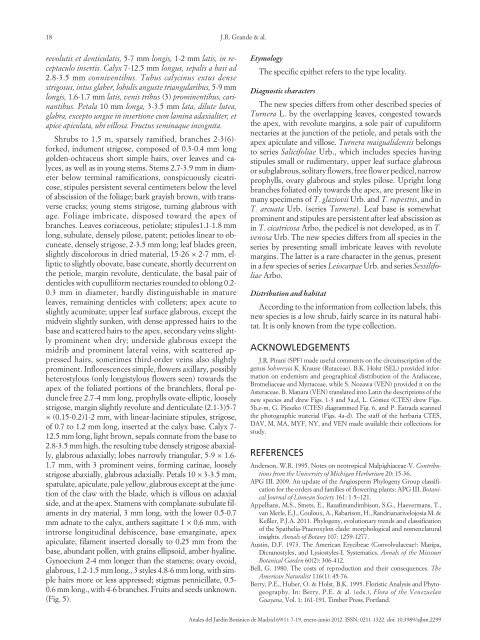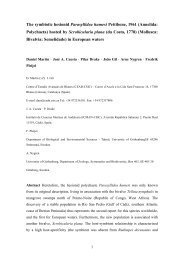Botanical novelties from Sierra de Maigualida, southern ... - CSIC
Botanical novelties from Sierra de Maigualida, southern ... - CSIC
Botanical novelties from Sierra de Maigualida, southern ... - CSIC
You also want an ePaper? Increase the reach of your titles
YUMPU automatically turns print PDFs into web optimized ePapers that Google loves.
18<br />
J.R. Gran<strong>de</strong> & al.<br />
revolutis et <strong>de</strong>nticulatis, 5-7 mm longis, 1-2 mm latis, in receptaculo<br />
insertis. Calyx 7-12.5 mm longus, sepalis a basi ad<br />
2.8-3.5 mm conniventibus. Tubus calycinus extus <strong>de</strong>nse<br />
strigosus, intus glaber, lo bulis anguste triangularibus, 5-9 mm<br />
longis, 1.6-1.7 mm latis, venis tribus (3) prominentibus, carinantibus.<br />
Petala 10 mm longa, 3-3.5 mm lata, dilute lu tea,<br />
glabra, excepto ungue in insertione cum lamina adaxialiter, et<br />
apice apiculata, ubi villosa. Fructus seminaque incognita.<br />
Shrubs to 1.5 m, sparsely ramified, branches 2-3(6)-<br />
forked, indument strigose, composed of 0.3-0.4 mm long<br />
gol<strong>de</strong>n-ochraceus short simple hairs, over leaves and calyces,<br />
as well as in young stems. Stems 2.7-3.9 mm in diameter<br />
below terminal ramifications, conspicuously cicatricose,<br />
stipules persistent several centimeters below the level<br />
of abscission of the foliage; bark grayish brown, with transverse<br />
cracks; young stems strigose, turning glabrous with<br />
age. Foliage imbricate, disposed toward the apex of<br />
branches. Leaves coriaceous, petiolate; stipules1.1-1.8 mm<br />
long, subulate, <strong>de</strong>nsely pilose, patent; petioles linear to obcuneate,<br />
<strong>de</strong>nsely strigose, 2-3.5 mm long; leaf bla<strong>de</strong>s green,<br />
slightly discolorous in dried material, 15-26 × 2-7 mm, elliptic<br />
to slightly obovate, base cuneate, shortly <strong>de</strong>current on<br />
the petiole, margin revolute, <strong>de</strong>nticulate, the basal pair of<br />
<strong>de</strong>nticles with cupulliform nectaries roun<strong>de</strong>d to oblong 0.2-<br />
0.3 mm in diameter, hardly distinguishable in mature<br />
leaves, remaining <strong>de</strong>nticles with colleters; apex acute to<br />
slightly acuminate; upper leaf surface glabrous, except the<br />
midvein slightly sunken, with <strong>de</strong>nse appressed hairs to the<br />
base and scattered hairs to the apex, secondary veins slightly<br />
prominent when dry; un<strong>de</strong>rsi<strong>de</strong> glabrous except the<br />
midrib and prominent lateral veins, with scattered appressed<br />
hairs, sometimes third-or<strong>de</strong>r veins also slightly<br />
prominent. Inflorescences simple, flowers axillary, possibly<br />
heterostylous (only longistylous flowers seen) towards the<br />
apex of the foliated portions of the branchlets, floral peduncle<br />
free 2.7-4 mm long, prophylls ovate-elliptic, loosely<br />
strigose, margin slightly revolute and <strong>de</strong>nticulate (2.1-3)5-7<br />
× (0.15-0.2)1-2 mm, with linear-laciniate stipules, strigose,<br />
of 0.7 to 1.2 mm long, inserted at the calyx base. Calyx 7-<br />
12.5 mm long, light brown, sepals connate <strong>from</strong> the base to<br />
2.8-3.5 mm high, the resulting tube <strong>de</strong>nsely strigose abaxially,<br />
glabrous adaxially; lobes narrowly triangular, 5-9 × 1.6-<br />
1.7 mm, with 3 prominent veins, forming carinae, loosely<br />
strigose abaxially, glabrous adaxially. Petals 10 × 3-3.5 mm,<br />
spatulate, apiculate, pale yellow, glabrous except at the junction<br />
of the claw with the bla<strong>de</strong>, which is villous on adaxial<br />
si<strong>de</strong>, and at the apex. Stamens with complanate-subulate filaments<br />
in dry material, 3 mm long, with the lower 0.5-0.7<br />
mm adnate to the calyx, anthers sagittate 1 × 0.6 mm, with<br />
introrse longitudinal <strong>de</strong>hiscence, base emarginate, apex<br />
apiculate, filament inserted dorsally to 0.25 mm <strong>from</strong> the<br />
base, abundant pollen, with grains ellipsoid, amber-hyaline.<br />
Gynoecium 2-4 mm longer than the stamens; ovary ovoid,<br />
glabrous, 1.2-1.5 mm long., 3 styles 4.8-6 mm long, with simple<br />
hairs more or less appressed; stigmas pennicillate, 0.5-<br />
0.6 mm long., with 4-6 branches. Fruits and seeds unknown.<br />
(Fig. 5).<br />
Etymology<br />
The specific epithet refers to the type locality.<br />
Diagnostic characters<br />
The new species differs <strong>from</strong> other <strong>de</strong>scribed species of<br />
Turnera L. by the overlapping leaves, congested towards<br />
the apex, with revolute margins, a sole pair of cupuliform<br />
nectaries at the junction of the petiole, and petals with the<br />
apex apiculate and villose. Turnera maiguali<strong>de</strong>nsis belongs<br />
to series Salicifoliae Urb., which inclu<strong>de</strong>s species having<br />
stipules small or rudimentary, upper leaf surface glabrous<br />
or subglabrous, solitary flowers, free flower pedicel, narrow<br />
prophylls, ovary glabrous and styles pilose. Upright long<br />
branches foliated only towards the apex, are present like in<br />
many specimens of T. glaziovii Urb. and T. rupestris, and in<br />
T. arcuata Urb. (series Turnera). Leaf base is somewhat<br />
prominent and stipules are persistent after leaf abscission as<br />
in T. cicatricosa Arbo, the pedicel is not <strong>de</strong>veloped, as in T.<br />
venosa Urb. The new species differs <strong>from</strong> all species in the<br />
series by presenting small imbricate leaves with revolute<br />
margins. The latter is a rare character in the genus, present<br />
in a few species of series Leiocarpae Urb. and series Sessilifoliae<br />
Arbo.<br />
Distribution and habitat<br />
According to the information <strong>from</strong> collection labels, this<br />
new species is a low shrub, fairly scarce in its natural habitat.<br />
It is only known <strong>from</strong> the type collection.<br />
ACKNOWLEDGEMENTS<br />
J.R. Pirani (SPF) ma<strong>de</strong> useful comments on the circumscription of the<br />
genus Sohnreyia K. Krause (Rutaceae). B.K. Holst (SEL) provi<strong>de</strong>d information<br />
on en<strong>de</strong>mism and geographical distribution of the Araliaceae,<br />
Bromeliaceae and Myrtaceae, while S. Nozawa (VEN) provi<strong>de</strong>d it on the<br />
Asteraceae. B. Manara (VEN) translated into Latin the <strong>de</strong>scriptions of the<br />
new species and drew Figs. 1-3 and 5a,d, L. Gómez (CTES) drew Figs.<br />
5b,e-m, G. Pieszko (CTES) diagrammed Fig. 6, and P. Estrada scanned<br />
the photographic material (Figs. 4a-d). The staff of the her baria CTES,<br />
DAV, M, MA, MYF, NY, and VEN ma<strong>de</strong> available their collections for<br />
study.<br />
REFERENCES<br />
An<strong>de</strong>rson, W.R. 1995. Notes on neotropical Malpighiaceae-V. Contributions<br />
<strong>from</strong> the University of Michigan Herbarium 20: 15-36.<br />
APG III. 2009. An update of the Angiosperm Phylogeny Group classification<br />
for the or<strong>de</strong>rs and families of flowering plants: APG III. <strong>Botanical</strong><br />
Journal of Linnean Society 161: 1-5–121.<br />
Appelhans, M.S., Smets, E., Razafimandimbison, S.G., Haevermans, T.,<br />
van Merle, E.J., Couloux, A., Rabarison, H., Randrianarivelojosia M. &<br />
Keßler, P.J.A. 2011. Phylogeny, evolutionary trends and classification<br />
of the Spathelia-Ptaeroxylon cla<strong>de</strong>: morphological and nomenclatural<br />
insights. Annals of Botany 107: 1259-1277.<br />
Austin, D.F. 1973. The American Erycibeae (Convolvulaceae): Maripa,<br />
Dicranostyles, and Lysiostyles-I. Systematics. Annals of the Missouri<br />
<strong>Botanical</strong> Gar<strong>de</strong>n 60(2): 306-412.<br />
Bell, G. 1980. The costs of reproduction and their consequences. The<br />
American Naturalist 116(1): 45-76.<br />
Berry, P.E., Huber, O. & Holst, B.K. 1995. Floristic Analysis and Phytogeography.<br />
In: Berry, P.E. & al. (eds.), Flora of the Venezuelan<br />
Guayana, Vol. 1: 161-191. Timber Press, Portland.<br />
Anales <strong>de</strong>l Jardín Botánico <strong>de</strong> Madrid 69(1): 7-19, enero-junio 2012. ISSN: 0211-1322. doi: 10.3989/ajbm.2299
















